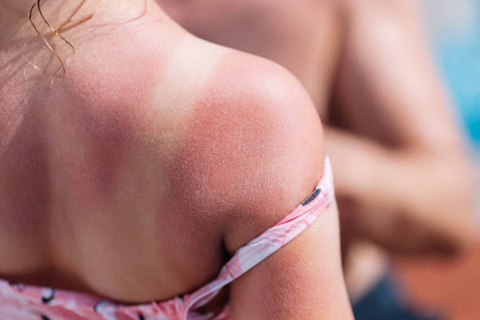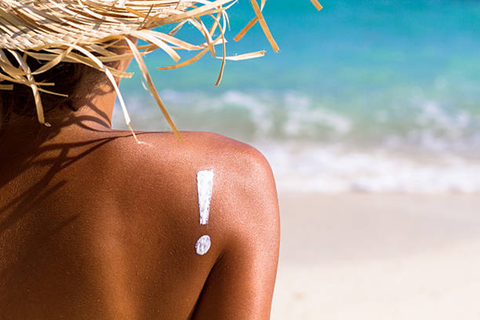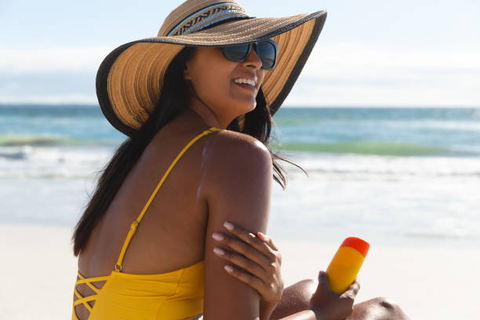
Can You Tan with Sunscreen? 5 secrets for sun-kissed tan
Share
There is a common misconception that wearing sunscreen prevents tanning altogether. While sunscreen does provide protection against the harmful effects of UV radiation, it does not completely block the sun's rays.
Therefore, it is still possible to tan while wearing sunscreen. But please keep on reading to find great tips on how to achieve the ultra tropical sun-kissed tan.
How does sunscreen work?
If you want to know how sunscreen works when you're tanning, you have to understand how tanning works. Tanning occurs when the skin is exposed to ultraviolet (UV) radiation from the sun or artificial light sources, such as those from tanning beds.
When UV rays penetrate the skin, they activate melanocytes, which are cells responsible for producing melanin, the pigment that gives the skin its color. There are more melanin production, the darker the skin will become. But these rays are responsible for the tanning process and also contribute to skin damage and the risk of protects your skin !

So sunscreen was created! Sunscreen is designed to protect the skin from the harmful effects of UV radiation, minimizing the risk of sunburn, premature aging, and skin cancer. It works by either absorbing or reflecting the UV rays, preventing them from reaching the skin. These are the reasons why it’s essential to wear sunscreen!
Debunking the myth: Can you really tan with sunscreen?
As mentioned above, sunscreen really acts as a barrier, but that doesn’t mean it’s inscrutable. In fact, there is no sunscreen here block out all the sun's rays. Even sunscreens sun protection factor (SPF) 100 is disable to do that.
So, you can still get some tan with sunscreen, especially for those types of skin tone that tan easily. It's just that the protection provided by sunscreen may prolong the time it takes to tan! All we have to do is find a way to maximize our tan while minimizing sun damage.
What SPF is best for tanning? SPF 30 or SPF 50?
A higher SPF means more protection from UVB radiation! The SPF factor will tell you how long you could stay under the sun without sunburns. But a higher SPF number does not mean that you are more protected.
This because UVA protection goes down when the SPF number goes up, so SPF100 does not contain higher protection than SPF 15 or 30. This also the reason why SPF 100 is not recommended!
You need to pick out a broad-spectrum sunscreen with prime ingredients, SPF 30 is always a good choice when you knoe you are going to be spending a lot of time for outdoor. Imagine you have bought a sunscreen SPF 30, it would take 30 times longer (about 300 minutes) to get that same tanlines you can get in 10 minutes without sunscreen. But it will takes 500 minutes to tan if you use an SPF factor 50 and so on following this logic!
It is crucial to find the right balance between tanning and sun protection. Consider your skin type, intensity of the sun, and how long you decide to spend in the sun when selecting an appropriate SPF.
How to tan for less time with sunscreen?
If you want to achieve a sun-kissed tan while using sunscreen, there are a few strategies you can employ to maximize your tanning potential. Here are some tips:

- Apply sunscreen strategically: Focus on applying sunscreen to areas that are more prone to burning, such as the face, shoulders, and back. This will provide some protection while allowing other areas to tan. Remember to apply it at least 30 minutes before going outside and reapply after swimming or sweating heavily to get the most protection.
- Gradual exposure: Start with shorter periods of UV exposure, and gradually increase the time over several days. This approach allows your skin to build up melanin and develop a tan more slowly and evenly.
- Exploring tan accelerators: Let's be frank, any amount of tan is technically considered sun damage, so the goal of sunscreen is to actually prevent you from getting a tan. Fortunately, there are other ways to achieve that golden glow while protecting your skin. Applying the tan accelerators containing ingredients that stimulate the production of melanin in the skin, which helps you achieve a tan more quickly and evenly.
By following these guidelines, you can achieve a tan while minimizing the amount of time spent in the sun and reducing the risk of sunburn and skin damage.
Achieving a tan that looks more natural and healthy
"There is no such thing as a safe or healthy tan", according to dermatologists. While tanning can enhance your appearance, it is important to prioritize achieving a tan that looks natural and healthy. Here are some tips to help you achieve a desirable tan with sunscreen:
- Exfoliate: Before tanning, exfoliate your skin to remove dead cells and ensure an even application of sunscreen and tanning products.
- Moisturize: Keeping your skin moisturized helps maintain its health, elasticity, and overall appearance. Use a moisturizer that is compatible with your skin type to prevent dryness and flakiness.
- Hydrate: Drinking plenty of water is essential for overall skin health. Hydrated skin has a better chance of tanning evenly and maintaining its glow.
- Avoid excessive sun exposure: Overexposure to the sun can lead to sunburn, premature aging, and an increased risk of skin cancer. Practice sun safety by limiting your time in the sun and seeking shade during peak hours.
By following these guidelines, you can achieve a tan that not only looks good but also promotes the long-term health of your skin.
Conclusion: Finding the right balance between sun protection and achieving a tan
There is no such thing as a safe or healthy tan. It’s important to reapply your sunscreen often and make it a part of your daily routine. The key to keeping your skin healthier and sun-kissed throughout your lifetime is to use the right sun protection, although the level of tanning may be reduced compared to unprotected skin.

To maximize your tanning potential, consider a SPF30 and strategic application. Remember to prioritize achieving a tan that looks natural and healthy by exfoliating, moisturizing, hydrating, and avoiding excessive sun exposure. If you prefer to tan less time to reduce sun exposure, outdoor tanning gels can be a great choose. By finding the right balance between sun protection and achieving a tan, you can enjoy the benefits of a healthy glow while minimizing the risks associated with excessive sun exposure.
Protect your skin and achieve a beautiful tan. Choose the right sunscreen and outdoor tanning products to find the perfect balance. Your skin will thank you!

